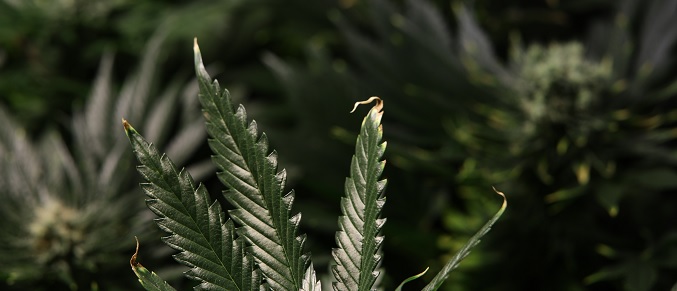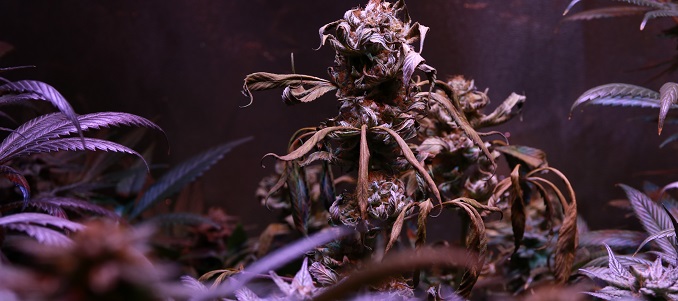What You Need To Know About Cannabis Nutrient Burn
Published :
Sep 8, 2017
Categories :
Cannabis cultivation

Nutrient burn is among the most commonly encountered problems when growing cannabis. In particular, new cannabis growers who don’t know that “less is more” are prone to overfeeding their plants, leading to nutrient burn and other growing problems. Learn about cannabis nutrient burn and how to avoid it.
Nutrient burn is usually the first symptom that appears after giving your cannabis plants too many nutrients. As a result of an overabundance of nutrients that the plants cannot use, the tips of the leaves start to become yellow or brown. When the nutrient burn hasn’t been addressed and progresses further, the top of the leaves will become brittle, dry, and twisted, giving the plant a “burnt” appearance, hence the name.
While you cannot “repair” the leaves that are showing signs of nutrient burn, you definitely want to stop the issue in its tracks to avoid further problems that could threaten your crop.
WHEN DOES NUTRIENT BURN HAPPEN?
Although rarely encountered in purely organic cannabis grows, nutrient burn can occur when growers feed their plants high levels of mineral nutrients. The difference with mineral-based nutrients, which happen to be the most common types of cannabis nutrients, and growing organically is that the former are readily available to the plant basically right out of the bottle. Because of this, it also means that it is easier to provide the plants with more nutrients than what they can handle.
Using modern, highly-concentrated cannabis nutrients isn’t the only cause of nutrient burn, however. Some commercially available potting mixes contain very high levels of nutrients, making these unsuitable for seedlings. Seedlings are particularly sensitive to high levels of nutrients and don’t take well to soil that is “too hot.”

Know that there aren’t many hard and fast rules when it comes to determining the optimal nutrient levels for your plants. Some strains may uptake a particular amount of cannabis nutrients well, while another strain (and possibly even another plant of the same strain!) may show signs of nute burn.
An overabundance of nutrients will normally show the classic signs of discoloured leaf tips, but nute burn also frequently manifests alongside nitrogen toxicity, causing plants to make leaves “claw” downwards as well.
HOW SERIOUS FOR YOUR CROPS IS CANNABIS NUTRIENT BURN?
A slight case of nutrient burn doesn't need to signal cause for alarm. If you recognise it early enough and address it, the damage to your plant and subsequent harvest will be minimal. A severe case of nutrient burn, however will make your plants lose significant leaf mass, seriously impacting the growth of your plants and success of your crop. An overabundance of nutrients that are not “flushed out” can also cause your bud to sustain an unpleasant, chemical taste.
NUTRIENT BURN DURING FLOWERING
When your plant is still in the vegetative growing phase and nute burn happens, it can easily make up for the damage by simply growing leaves elsewhere. Yes, it may not look pretty, but it shouldn’t be a major concern as long as you act early and solve the whole problem.
Yet in the flowering stage, cannabis plants put all their energy into the buds, rather than growing leaves and stems. This is also why the flowering stage is the most critical period of growth. While a slight case of nute burn during flowering may be tolerable, the plant cannot recover from a severe case in which massive amounts of leaves have turned. Because of this, you should be especially careful when giving nutes in the flowering stage. If you want to keep the risk low, you should always start with less than the recommended dosage of the particular type of nutrients you are using.

WHAT TO DO ABOUT CANNABIS NUTRIENT BURN
With the exception of possibly providing your seedlings with too many nutrients when using “hot” soil, nutrient burn most often occurs when you feed your plants excessive nutrients. The first thing you should do is make sure that you’re giving your plants the correct type of nutes depending on their growing stage.
Concerning cannabis, nutrients are normally available in different formulations catered to each specific part of the growth cycle. Make sure you administer the right type of nutrients in every stage. Failure to do this could result in nutrient burn.
Know that many manufacturers of commercial cannabis nutrients are going well overboard with their recommended dosages. After all, these companies make money from you using their products. Most of the time, these “recommendations” can be far off from what is truly ideal for your plants. It is a good idea to start with half of the recommended dosage and only give more later-on when your plants show signs of deficiency.
FLUSHING
The first thing that you should do upon seeing signs of nute burn in soil or coco grows is to flush your plants with plain pH’ed water. Flushing means that you water your plants with a generous amount of pH-optimised water only to get rid of (“flush out”) any excess minerals and salts harming your plants or tampering with bud quality. Most of the time, this can be all that’s needed. Once your plant has used up the remaining nutrients and is recovering, you will know that it has moved on as new growth appears healthy.
Similarly, when you grow hydroponically and spot nute burn signs, you want to reduce the nutrient level in your water reservoir. You can either add more plain pH’ed water to your reservoir to dilute your system’s nutrient solution entirely, or simply lower the level. When you grow hydroponically, you will want a TDS meter that lets you know about the correct nutrient levels in your solution. Should you not have a TDS meter on hand for whatever reason, you can use about half of the amount of nutrients that you used previously for your hydro as a quick emergency workaround.
Nutrient burn can happen to every grower. Fortunately, it doesn’t have to cause you major headaches once you know how to spot the signs and quickly solve the problem.







































